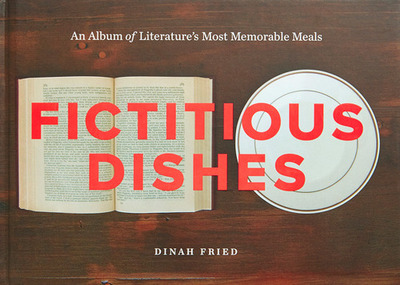In Good Books
Over the past week or so, five or six people have sent me a link to a Brain Pickings post about Dinah Fried’s new book, Fictitious Dishes: An Album of Literature’s Most Memorable Meals. What began as a project at the Rhode Island School of Design soon transformed into an attempt to recreate, and then photograph, meals eaten in well-known novels.
Fried includes the picnic of baked potatoes and eggs (I’ve never encountered a baked egg, have you?) from The Secret Garden, the avocado and crabmeat lunch that causes riotous vomiting among the finalists of the Ladies’ Day writing competition in The Bell Jar, the chowder in Moby-Dick, and Holden Caulfield’s cheese sandwich and milkshake.
Food, like sex (as the annual Bad Sex Award makes abundantly clear), is very difficult to write about without descending into cliché or embarrassingly purple prose. There are some writers who evoke cooking and eating particularly well. I think immediately of AS Byatt and her descriptions of the jugged hare in The Biographer’s Tale, and the tennis ball-sized profiteroles in a lake of chocolate sauce consumed by awkward Maud and Roland in Whitby in Possession. Virginia Woolf, for all her complex problems with eating, writes well about food too: the boeuf en daube in To the Lighthouse, for instance, and the evocation of the meals eaten in the men and women’s colleges in A Room of One’s Own.
In fact, her description of the food at the latter institution (the ‘plain gravy soup’, the ‘sprouts curled and yellowed at the edge’, the ‘prunes and custard’, and the ‘dry’ biscuits) is an excellent portrayal of unappetising food. In The Years Woolf writes about a depressing dinner consisting of a tough, underdone leg of mutton (when it’s sliced with a carving knife a ‘thin trickle of red juice ran out’ and collects ‘in the well of the dish’), ‘a slabbed-down mass of cabbage in oozing green water’, and ‘yellow potatoes that looked hard.’
In A Passage to India, EM Forster writes about the meals served at the club for British officers and civil servants:
Julienne soup full of bullety bottled peas, pseudo-cottage bread, fish full of branching bones, pretending to be plaice, more bottled peas with the cutlets, trifle, sardines on toast: the menu of Anglo-India. A dish might be added or subtracted as one rose or fell in the official scale, the peas might rattle less or more, the sardines and the vermouth be imported by a different firm, but the tradition remained; the food of exiles, cooked by servants who did not understand it.
In Jane Eyre our heroine arrives at Lowood School to discover that her fellow pupils exist on the brink of starvation:
Ravenous, and now very faint, I devoured a spoonful or two of my portion without thinking of its taste; but the first edge of hunger blunted, I perceived I had got in hand a nauseous mess; burnt porridge is almost as bad as rotten potatoes; famine itself soon sickens over it. The spoons were moved slowly: I saw each girl taste her food and try to swallow it; but in most cases the effort was soon relinquished. Breakfast was over, and none had breakfasted. Thanks being returned for what we had not got, and a second hymn chanted, the refectory was evacuated for the schoolroom. I was one of the last to go out, and in passing the tables, I saw one teacher take a basin of the porridge and taste it; she looked at the others; all their countenances expressed displeasure, and one of them, the stout one, whispered –
‘Abominable stuff! How shameful!’
Paul Bowles’s The Sheltering Sky is, in some ways, a progression of increasingly appalling meals. The subject of Margaret Atwood’s first novel The Edible Woman is disgust at food: the protagonist, Marion, finds herself unable to eat a variety of foods as she begins to anthropomorphise everything she tries to cook, including cake and tinned rice pudding.
In her discussion of Fried’s book, Maria Popova writes about the ways in which both food and reading are different kinds of nourishment: for the body, and for the mind (and the soul, I think she’d add). But reading has another history too. As Jane Austen – who uses food skillfully to demonstrate both class divisions and her characters’ pretensions – parodies in Northanger Abbey, young women in the late eighteenth and nineteenth centuries were warned against the effects not only of reading frivolous novels, but of reading too much. This kind of binge reading was believed to be as bad for the morals, as eating too much was harmful to health. Marianne Dashwood’s reckless, wild behaviour in Sense and Sensibility is partly the product of too much reading. (Although Austen implies that her sensible sister Eleanor could certainly read a little more.)
We celebrate the value of reading – and voracious reading – so much at the moment that we forget that it hasn’t always been seen as an unalloyed virtue. Novels, especially, were held up as potentially dangerous to impressionable young (female) minds, in much the same way as video games and the internet have been in the twentieth- and twenty-first century. Victorian moralists argued that in the case of both sweets and Mrs Radcliffe, they could be too much of a good thing.

Tangerine and Cinnamon by Sarah Duff is licensed under a Creative Commons Attribution-ShareAlike 3.0 Unported License.




